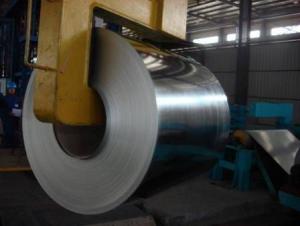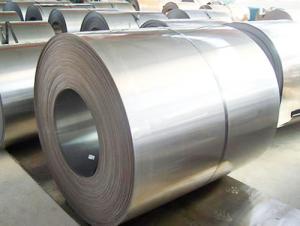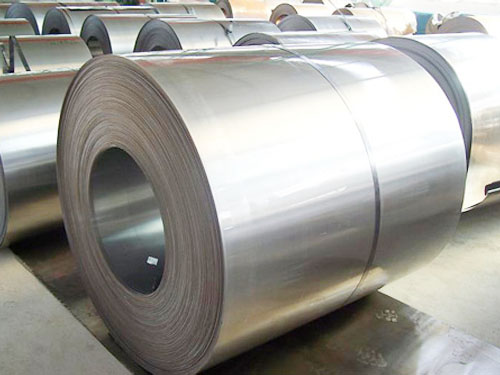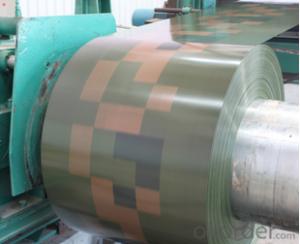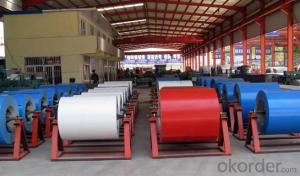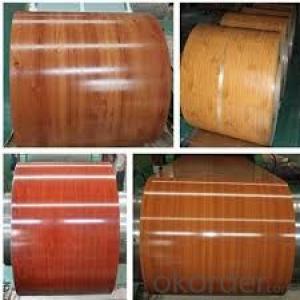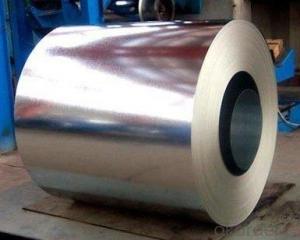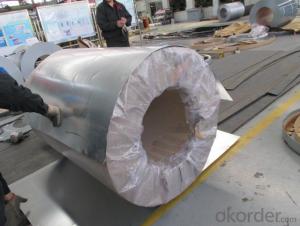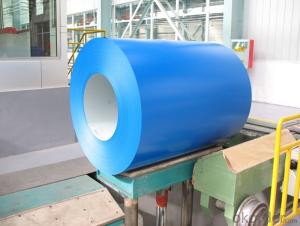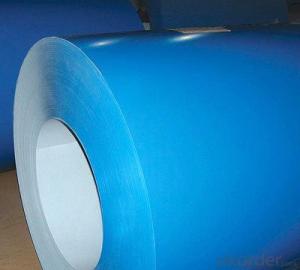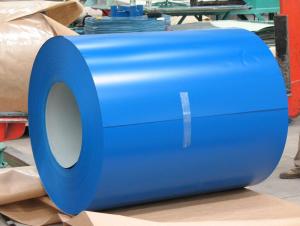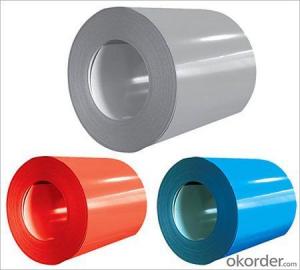Galvanized Steel Coils ISO9001:2008 BV SGS CE
- Loading Port:
- Tianjin
- Payment Terms:
- TT or LC
- Min Order Qty:
- 22 m.t.
- Supply Capability:
- 32 m.t./month
OKorder Service Pledge
OKorder Financial Service
You Might Also Like
1.Structure of Prepainted Galvanized steel Coil :
With Gi as base metal,after pretreatmet (degrease and chemical treatment) and liquid dope with several Layers of color,then after firing and cooling,finally the plate steel is called pre-painted galvanized steel ( PPGI) .Pre-painted galvanized steel is good capable of decoration ,molding,corrosion resistance
2.Main Features of Prepainted Galvanized steel Coil:
• Excellent process capability
• Smooth and flat surface
• Workability, durability
• Excellent heat resistance performance
• High strength
• Good formability
• Good visual effect
3.Prepainted Galvanized steel Coil Images
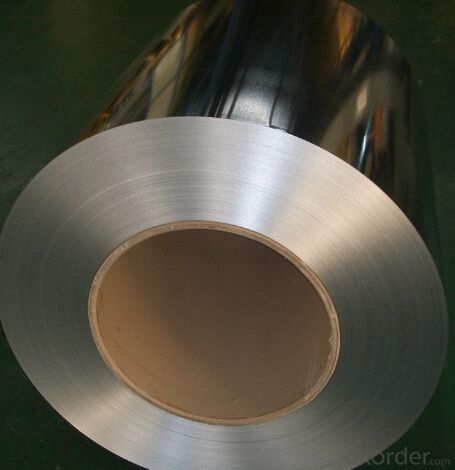
4.Prepainted Galvanized steel Coil Specification
Standard:ASTM, GB,JIS,JIS G3302 ASTM 755 EN10169
Grade: DX51D CGCC CS
Thickness: 0.13mm~3.0mm,
Width: 1250,600-1250mm
Coil weight:3-12 MT
Coil ID:508/610mm
Chemical composition:
NAME | PPGI | GALVANIZED | GALVALUME/ALUZINC |
CERTIFICATE | ISO9001:2008 BV SGS | ||
GRADE | CGCC | SS GRADE33-80 | GRADE33-80 |
MODEL NO | 0.16MM-0.8MM*1250MM OR UNDER | 0.127-1.2*1250MM OR UNDER | 0.12MM-2MM*1250MM OR UNDER |
TYPE | Steel coil,Steel sheets/plates,Corrugated steel sheets/plates | ||
TECHNIQUE | Ccold rolled-galvalume /galvanized-PPGI/PPGL | Cold rolled- galvanized | Cold rolled-galvalume /Aluzinc |
SURFACE | Mini/regular/big/zero spangle, | ||
TREATMENT | Chromate treatment /chromate-free treatment /untreated unoile/oiled,TENSION LEVELLERT SKIN PASS anti-fingerprint/un-anti-fingerprint,Coating,color | ||
APPLICATION | Structural use ,roofing, commercial use, household appliance, industry, family | ||
5.FAQ of Prepainted Galvanized steel Coi
We have organized several common questions for our clients,may help you sincerely:
1.How do you control your quality
We have established the international advanced quality management system,every link from raw material to final product we have strict quality test;We resolutely put an end to unqualified products flowing into the market. At the same time, we will provide necessary follow-up service assurance.
2.how long we will receive the goods ?
After receiving your deposit or workable lc ,our normal shipment date is 15-20days,and it takes around 28 days to reach your port of destination. But is up to different destination
3. what is your moq
Normally our moq is 25per size ,but it is up to different size
- Q: We just installed a stainless steel electric stove, what is the best way to keep it clean and shiney?
- Contact a sanitary supply company for a product to maintain stainless steel.
- Q: What are the dimensions of steel coils?
- The dimensions of steel coils vary depending on factors such as the specific type of steel, the intended use, and industry standards. Generally, steel coils can range in width from a few inches to several feet, with thicknesses typically ranging from a fraction of an inch to several millimeters. The inner diameter of a steel coil can also vary, with common sizes being 20 inches and 24 inches. Ultimately, the dimensions of steel coils are determined by the specific needs and requirements of the end user.
- Q: I'm looking for a steel plate for an design project that requires neodymium magnets to be stuck on them. I am trying to figure out what kind of steel plate would have hold the magnets up the best.
- the more the iron the more ferrous it is which means magnets stick better the best would be using iron alloy (mainly iron) but you could also use really any type of steel (almost all alloys contain iron)
- Q: What are the challenges faced in the recycling of steel coils?
- One of the main challenges in recycling steel coils is the process of separating the different materials that may be attached to the coils, such as plastic or paper. These contaminants need to be removed before the steel can be recycled efficiently. Additionally, the size and weight of steel coils can pose logistical challenges in terms of transportation and storage. Lastly, ensuring that the recycled steel meets the required quality standards and specifications is another challenge faced in the recycling process.
- Q: What are the common methods of slitting steel coils?
- There are several common methods of slitting steel coils, each with its own advantages and applications. 1. Rotary Shear Slitting: This method involves using rotary cutting knives to slit the steel coil. The coil is fed through the rotary shear machine, and the knives make simultaneous cuts along the length of the coil. Rotary shear slitting is known for its high-speed operation and ability to handle thicker gauge materials. 2. Loop Slitting: Loop slitting is a method where the steel coil is fed into a looping pit, creating a loop of material. The loop is then pulled through a set of knives that make the slits. This method is commonly used for thin gauge materials and provides precise cuts with minimal burr. 3. Drag Slitting: In drag slitting, the steel coil is fed through a set of driven rolls or drag pads, which help to maintain tension on the material. The coil is then guided through circular knives that make the slits. Drag slitting is suitable for various gauges of steel and offers good accuracy and edge quality. 4. Crush Slitting: Crush slitting involves passing the steel coil through a set of rolls, where one roll is rubber-covered and the other is hard. The rubber roll compresses the material against the hard roll, creating the slits. This method is commonly used for thin gauge or delicate materials as it minimizes the risk of edge damage. 5. Laser Slitting: Laser slitting utilizes a high-powered laser beam to make precise cuts on the steel coil. This method is highly accurate and allows for complex slitting patterns and narrow width cuts. Laser slitting is often used for high-end applications that require superior edge quality. Each of these methods has its own advantages and is chosen based on factors such as material thickness, desired edge quality, production speed, and cost considerations. It is important to carefully select the appropriate slitting method to ensure the desired outcome and efficiency in steel coil processing.
- Q: What are the main factors that affect the flatness of steel coils?
- The main factors that affect the flatness of steel coils are the quality and thickness of the steel material, the tension and speed of the rolling process, the temperature and cooling rate during the cooling process, and any potential defects or imperfections in the machinery used for rolling and cooling the steel coils.
- Q: I have two guitars, a nylon stringed classical, and a steel stringed acoustic, I find the nylon strings easier to play, but doesn't have as good of sound as the steel stringed, and when I play with the steel strings, it really hurts my fingers, and if I play just a little bit, it feels like the high e string is going to cut my finger. Are the strings too high? What can I do to make the steel strings easier to play?
- find an online tuner and tune the strings to the tuning you want. trust me, guitar hurts your fingers after a while. but your skin gets used to it's, it's what ever.
- Q: What are the different methods of coil slitting for steel coils?
- There are several methods of coil slitting for steel coils, including rotary shear slitting, loop slitting, and drag slitting. Rotary shear slitting involves using rotating knives to cut the coil into narrower strips. Loop slitting involves creating a loop in the coil and feeding it through a set of knives to slit it. Drag slitting involves pulling the coil through stationary knives to slit it. Each method has its own advantages and is chosen based on the specific requirements of the application.
- Q: How do steel coils contribute to the packaging industry?
- Steel coils are widely used in the packaging industry as they provide strength, durability, and stability to packaging materials. They are commonly used to produce metal strapping and wire, which are essential for securing and bundling goods during transportation. Additionally, steel coils are used in the production of metal cans and containers, offering a robust and reliable solution for packaging various products.
- Q: What are the different testing methods used for steel coils?
- There are several testing methods used for steel coils, including visual inspection, dimensional measurement, hardness testing, tensile testing, chemical analysis, and non-destructive testing techniques such as ultrasonic testing and magnetic particle inspection. These methods help ensure the quality and integrity of steel coils, allowing for accurate assessment of their mechanical properties, composition, and structural soundness.
Send your message to us
Galvanized Steel Coils ISO9001:2008 BV SGS CE
- Loading Port:
- Tianjin
- Payment Terms:
- TT or LC
- Min Order Qty:
- 22 m.t.
- Supply Capability:
- 32 m.t./month
OKorder Service Pledge
OKorder Financial Service
Similar products
Hot products
Hot Searches
Related keywords
